MGT4227 Leadership: Steve Jobs' Style, Performance & Motivation
VerifiedAdded on 2023/04/26
|10
|2406
|332
Report
AI Summary
This report analyzes the leadership style of Steve Jobs and its impact on the performance of Apple Inc., contrasting it with the leadership styles of Bill Gates and Kim-Ki-Nam. It discusses how Jobs' situational leadership contributed to Apple's success, focusing on his ability to articulate a vision, drive innovation, and motivate employees. The report also examines the participative leadership style of Bill Gates at Microsoft and the authoritarian style of Kim-Ki-Nam at Samsung, highlighting the differences in their approaches and organizational cultures. The analysis includes the impact of these leadership styles on employee motivation, organizational performance, and overall business success. The report concludes that effective leadership is crucial for driving business performance and fostering a dynamic organizational culture.
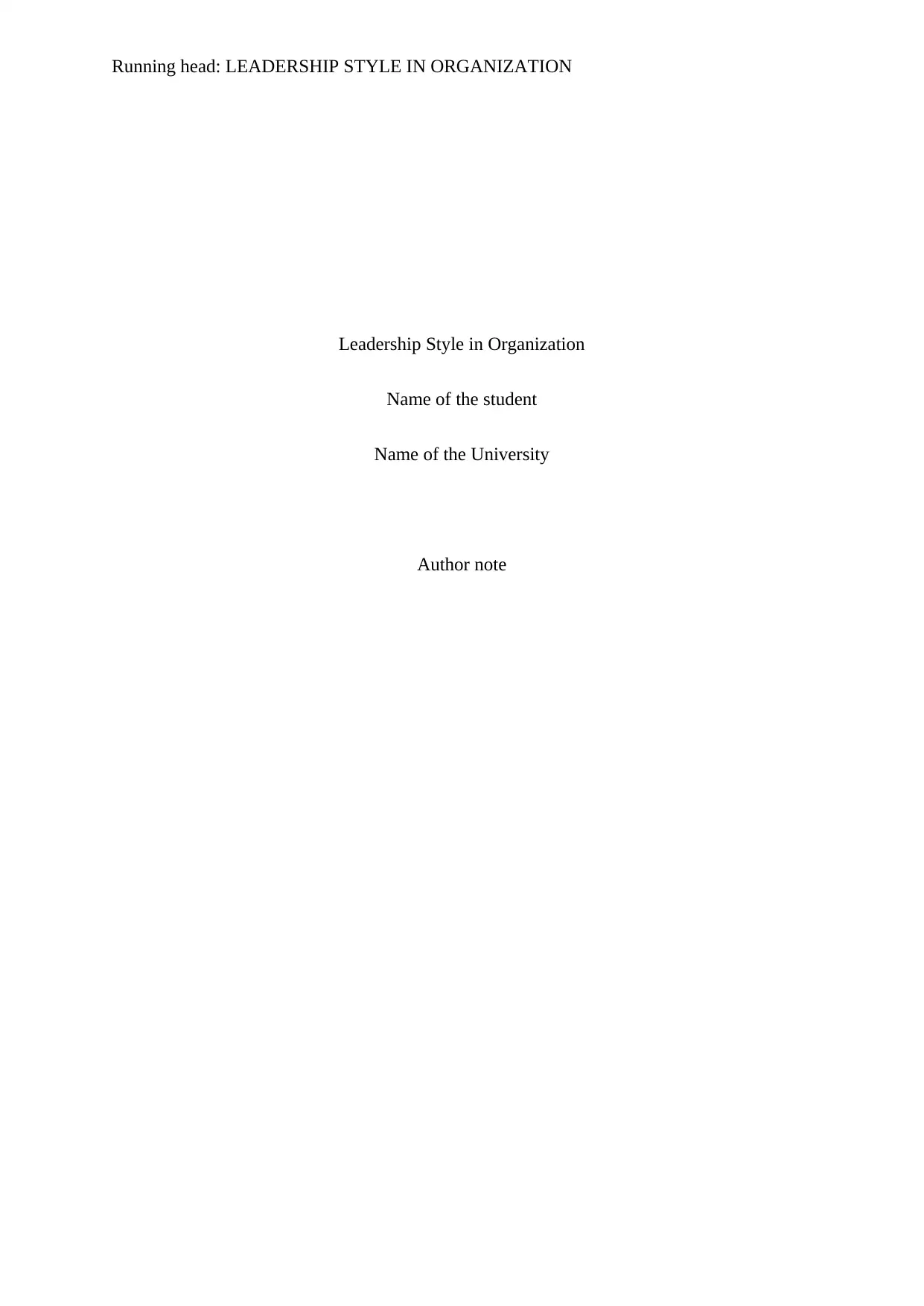
Running head: LEADERSHIP STYLE IN ORGANIZATION
Leadership Style in Organization
Name of the student
Name of the University
Author note
Leadership Style in Organization
Name of the student
Name of the University
Author note
Paraphrase This Document
Need a fresh take? Get an instant paraphrase of this document with our AI Paraphraser
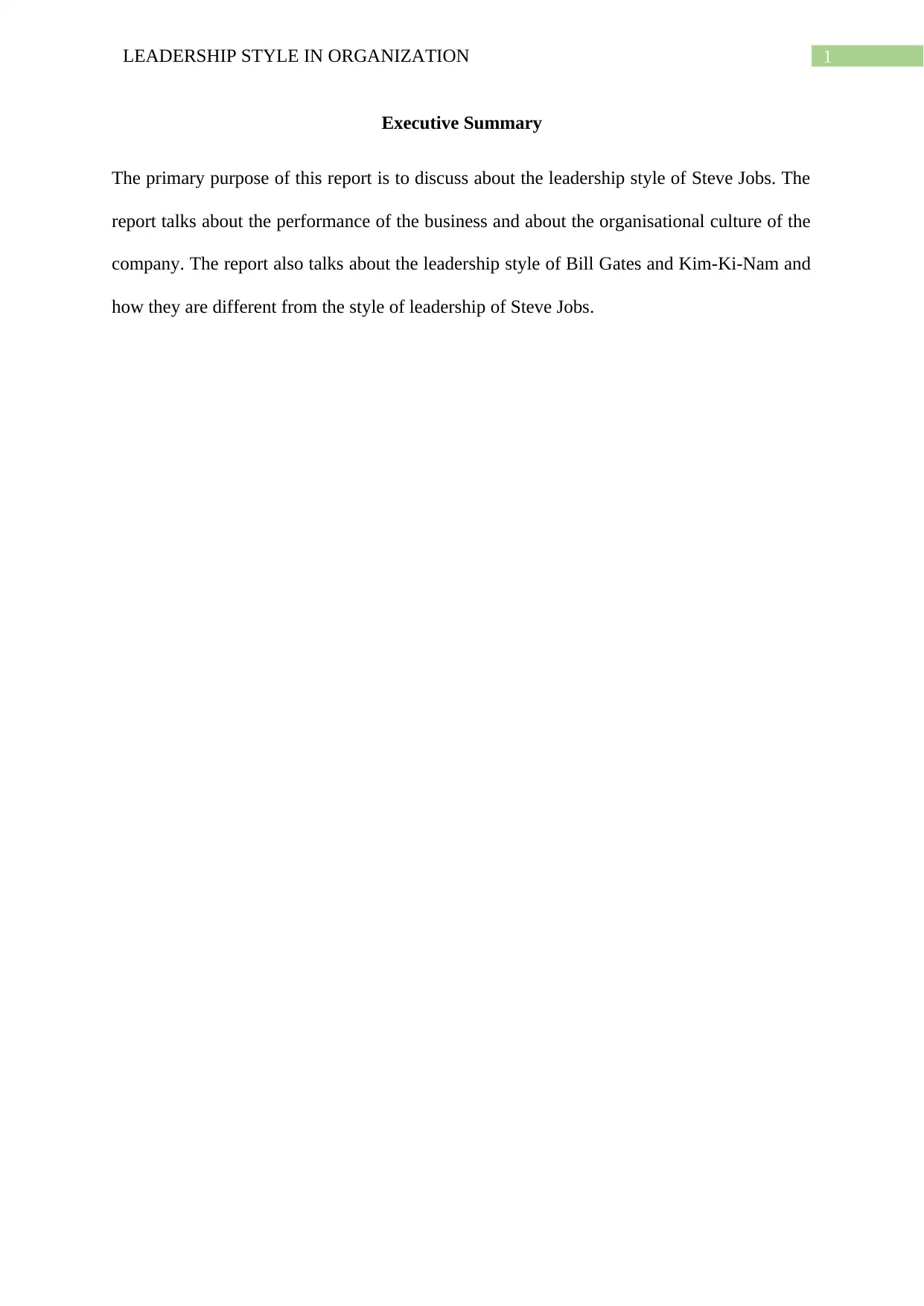
1LEADERSHIP STYLE IN ORGANIZATION
Executive Summary
The primary purpose of this report is to discuss about the leadership style of Steve Jobs. The
report talks about the performance of the business and about the organisational culture of the
company. The report also talks about the leadership style of Bill Gates and Kim-Ki-Nam and
how they are different from the style of leadership of Steve Jobs.
Executive Summary
The primary purpose of this report is to discuss about the leadership style of Steve Jobs. The
report talks about the performance of the business and about the organisational culture of the
company. The report also talks about the leadership style of Bill Gates and Kim-Ki-Nam and
how they are different from the style of leadership of Steve Jobs.

2LEADERSHIP STYLE IN ORGANIZATION
Table of Contents
Introduction................................................................................................................................3
Leadership style of Steve Jobs...................................................................................................3
Leadership Style of Bill Gates and Kim Ki Nam.......................................................................5
Conclusion..................................................................................................................................6
References..................................................................................................................................8
Table of Contents
Introduction................................................................................................................................3
Leadership style of Steve Jobs...................................................................................................3
Leadership Style of Bill Gates and Kim Ki Nam.......................................................................5
Conclusion..................................................................................................................................6
References..................................................................................................................................8
⊘ This is a preview!⊘
Do you want full access?
Subscribe today to unlock all pages.

Trusted by 1+ million students worldwide
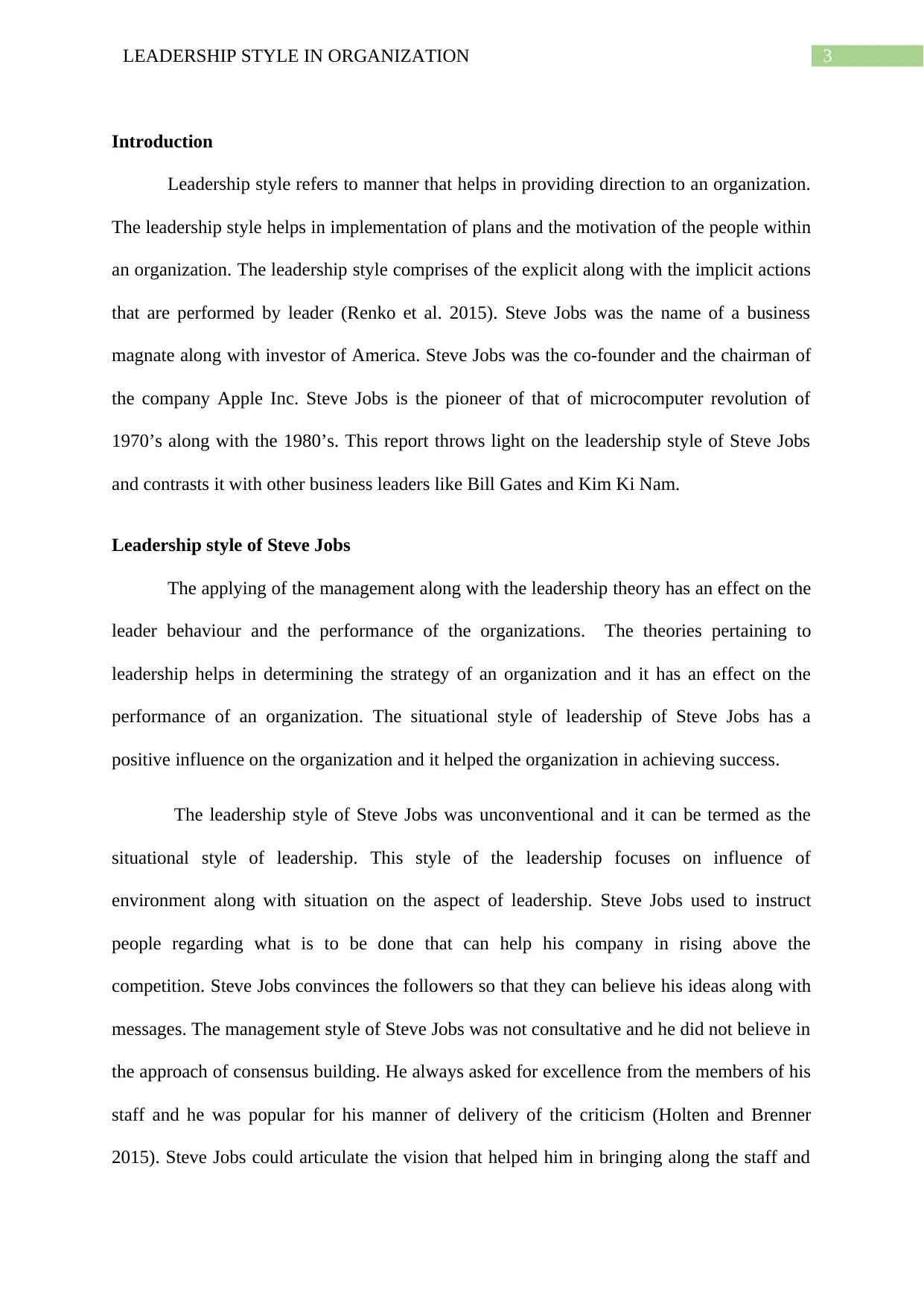
3LEADERSHIP STYLE IN ORGANIZATION
Introduction
Leadership style refers to manner that helps in providing direction to an organization.
The leadership style helps in implementation of plans and the motivation of the people within
an organization. The leadership style comprises of the explicit along with the implicit actions
that are performed by leader (Renko et al. 2015). Steve Jobs was the name of a business
magnate along with investor of America. Steve Jobs was the co-founder and the chairman of
the company Apple Inc. Steve Jobs is the pioneer of that of microcomputer revolution of
1970’s along with the 1980’s. This report throws light on the leadership style of Steve Jobs
and contrasts it with other business leaders like Bill Gates and Kim Ki Nam.
Leadership style of Steve Jobs
The applying of the management along with the leadership theory has an effect on the
leader behaviour and the performance of the organizations. The theories pertaining to
leadership helps in determining the strategy of an organization and it has an effect on the
performance of an organization. The situational style of leadership of Steve Jobs has a
positive influence on the organization and it helped the organization in achieving success.
The leadership style of Steve Jobs was unconventional and it can be termed as the
situational style of leadership. This style of the leadership focuses on influence of
environment along with situation on the aspect of leadership. Steve Jobs used to instruct
people regarding what is to be done that can help his company in rising above the
competition. Steve Jobs convinces the followers so that they can believe his ideas along with
messages. The management style of Steve Jobs was not consultative and he did not believe in
the approach of consensus building. He always asked for excellence from the members of his
staff and he was popular for his manner of delivery of the criticism (Holten and Brenner
2015). Steve Jobs could articulate the vision that helped him in bringing along the staff and
Introduction
Leadership style refers to manner that helps in providing direction to an organization.
The leadership style helps in implementation of plans and the motivation of the people within
an organization. The leadership style comprises of the explicit along with the implicit actions
that are performed by leader (Renko et al. 2015). Steve Jobs was the name of a business
magnate along with investor of America. Steve Jobs was the co-founder and the chairman of
the company Apple Inc. Steve Jobs is the pioneer of that of microcomputer revolution of
1970’s along with the 1980’s. This report throws light on the leadership style of Steve Jobs
and contrasts it with other business leaders like Bill Gates and Kim Ki Nam.
Leadership style of Steve Jobs
The applying of the management along with the leadership theory has an effect on the
leader behaviour and the performance of the organizations. The theories pertaining to
leadership helps in determining the strategy of an organization and it has an effect on the
performance of an organization. The situational style of leadership of Steve Jobs has a
positive influence on the organization and it helped the organization in achieving success.
The leadership style of Steve Jobs was unconventional and it can be termed as the
situational style of leadership. This style of the leadership focuses on influence of
environment along with situation on the aspect of leadership. Steve Jobs used to instruct
people regarding what is to be done that can help his company in rising above the
competition. Steve Jobs convinces the followers so that they can believe his ideas along with
messages. The management style of Steve Jobs was not consultative and he did not believe in
the approach of consensus building. He always asked for excellence from the members of his
staff and he was popular for his manner of delivery of the criticism (Holten and Brenner
2015). Steve Jobs could articulate the vision that helped him in bringing along the staff and
Paraphrase This Document
Need a fresh take? Get an instant paraphrase of this document with our AI Paraphraser
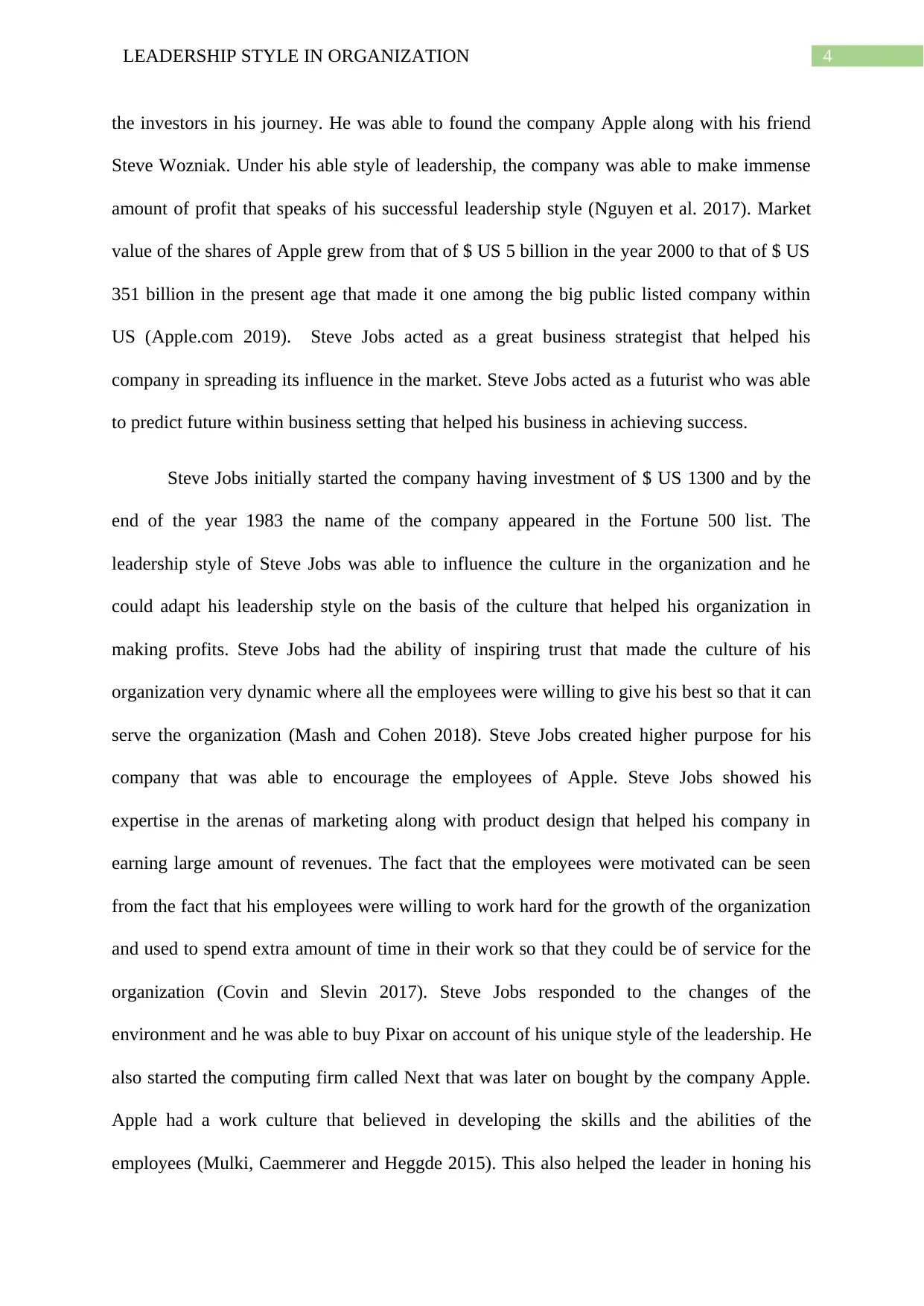
4LEADERSHIP STYLE IN ORGANIZATION
the investors in his journey. He was able to found the company Apple along with his friend
Steve Wozniak. Under his able style of leadership, the company was able to make immense
amount of profit that speaks of his successful leadership style (Nguyen et al. 2017). Market
value of the shares of Apple grew from that of $ US 5 billion in the year 2000 to that of $ US
351 billion in the present age that made it one among the big public listed company within
US (Apple.com 2019). Steve Jobs acted as a great business strategist that helped his
company in spreading its influence in the market. Steve Jobs acted as a futurist who was able
to predict future within business setting that helped his business in achieving success.
Steve Jobs initially started the company having investment of $ US 1300 and by the
end of the year 1983 the name of the company appeared in the Fortune 500 list. The
leadership style of Steve Jobs was able to influence the culture in the organization and he
could adapt his leadership style on the basis of the culture that helped his organization in
making profits. Steve Jobs had the ability of inspiring trust that made the culture of his
organization very dynamic where all the employees were willing to give his best so that it can
serve the organization (Mash and Cohen 2018). Steve Jobs created higher purpose for his
company that was able to encourage the employees of Apple. Steve Jobs showed his
expertise in the arenas of marketing along with product design that helped his company in
earning large amount of revenues. The fact that the employees were motivated can be seen
from the fact that his employees were willing to work hard for the growth of the organization
and used to spend extra amount of time in their work so that they could be of service for the
organization (Covin and Slevin 2017). Steve Jobs responded to the changes of the
environment and he was able to buy Pixar on account of his unique style of the leadership. He
also started the computing firm called Next that was later on bought by the company Apple.
Apple had a work culture that believed in developing the skills and the abilities of the
employees (Mulki, Caemmerer and Heggde 2015). This also helped the leader in honing his
the investors in his journey. He was able to found the company Apple along with his friend
Steve Wozniak. Under his able style of leadership, the company was able to make immense
amount of profit that speaks of his successful leadership style (Nguyen et al. 2017). Market
value of the shares of Apple grew from that of $ US 5 billion in the year 2000 to that of $ US
351 billion in the present age that made it one among the big public listed company within
US (Apple.com 2019). Steve Jobs acted as a great business strategist that helped his
company in spreading its influence in the market. Steve Jobs acted as a futurist who was able
to predict future within business setting that helped his business in achieving success.
Steve Jobs initially started the company having investment of $ US 1300 and by the
end of the year 1983 the name of the company appeared in the Fortune 500 list. The
leadership style of Steve Jobs was able to influence the culture in the organization and he
could adapt his leadership style on the basis of the culture that helped his organization in
making profits. Steve Jobs had the ability of inspiring trust that made the culture of his
organization very dynamic where all the employees were willing to give his best so that it can
serve the organization (Mash and Cohen 2018). Steve Jobs created higher purpose for his
company that was able to encourage the employees of Apple. Steve Jobs showed his
expertise in the arenas of marketing along with product design that helped his company in
earning large amount of revenues. The fact that the employees were motivated can be seen
from the fact that his employees were willing to work hard for the growth of the organization
and used to spend extra amount of time in their work so that they could be of service for the
organization (Covin and Slevin 2017). Steve Jobs responded to the changes of the
environment and he was able to buy Pixar on account of his unique style of the leadership. He
also started the computing firm called Next that was later on bought by the company Apple.
Apple had a work culture that believed in developing the skills and the abilities of the
employees (Mulki, Caemmerer and Heggde 2015). This also helped the leader in honing his
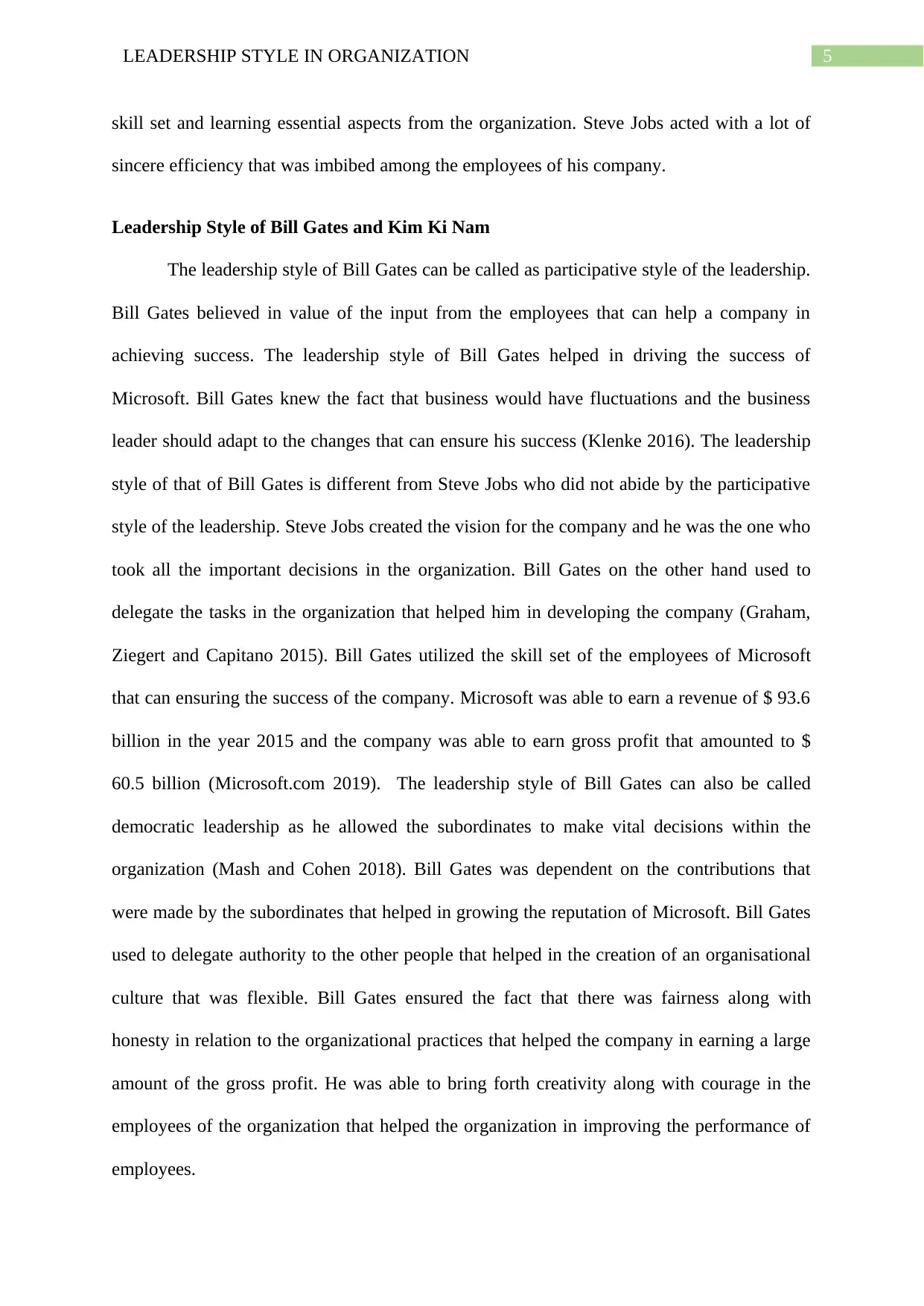
5LEADERSHIP STYLE IN ORGANIZATION
skill set and learning essential aspects from the organization. Steve Jobs acted with a lot of
sincere efficiency that was imbibed among the employees of his company.
Leadership Style of Bill Gates and Kim Ki Nam
The leadership style of Bill Gates can be called as participative style of the leadership.
Bill Gates believed in value of the input from the employees that can help a company in
achieving success. The leadership style of Bill Gates helped in driving the success of
Microsoft. Bill Gates knew the fact that business would have fluctuations and the business
leader should adapt to the changes that can ensure his success (Klenke 2016). The leadership
style of that of Bill Gates is different from Steve Jobs who did not abide by the participative
style of the leadership. Steve Jobs created the vision for the company and he was the one who
took all the important decisions in the organization. Bill Gates on the other hand used to
delegate the tasks in the organization that helped him in developing the company (Graham,
Ziegert and Capitano 2015). Bill Gates utilized the skill set of the employees of Microsoft
that can ensuring the success of the company. Microsoft was able to earn a revenue of $ 93.6
billion in the year 2015 and the company was able to earn gross profit that amounted to $
60.5 billion (Microsoft.com 2019). The leadership style of Bill Gates can also be called
democratic leadership as he allowed the subordinates to make vital decisions within the
organization (Mash and Cohen 2018). Bill Gates was dependent on the contributions that
were made by the subordinates that helped in growing the reputation of Microsoft. Bill Gates
used to delegate authority to the other people that helped in the creation of an organisational
culture that was flexible. Bill Gates ensured the fact that there was fairness along with
honesty in relation to the organizational practices that helped the company in earning a large
amount of the gross profit. He was able to bring forth creativity along with courage in the
employees of the organization that helped the organization in improving the performance of
employees.
skill set and learning essential aspects from the organization. Steve Jobs acted with a lot of
sincere efficiency that was imbibed among the employees of his company.
Leadership Style of Bill Gates and Kim Ki Nam
The leadership style of Bill Gates can be called as participative style of the leadership.
Bill Gates believed in value of the input from the employees that can help a company in
achieving success. The leadership style of Bill Gates helped in driving the success of
Microsoft. Bill Gates knew the fact that business would have fluctuations and the business
leader should adapt to the changes that can ensure his success (Klenke 2016). The leadership
style of that of Bill Gates is different from Steve Jobs who did not abide by the participative
style of the leadership. Steve Jobs created the vision for the company and he was the one who
took all the important decisions in the organization. Bill Gates on the other hand used to
delegate the tasks in the organization that helped him in developing the company (Graham,
Ziegert and Capitano 2015). Bill Gates utilized the skill set of the employees of Microsoft
that can ensuring the success of the company. Microsoft was able to earn a revenue of $ 93.6
billion in the year 2015 and the company was able to earn gross profit that amounted to $
60.5 billion (Microsoft.com 2019). The leadership style of Bill Gates can also be called
democratic leadership as he allowed the subordinates to make vital decisions within the
organization (Mash and Cohen 2018). Bill Gates was dependent on the contributions that
were made by the subordinates that helped in growing the reputation of Microsoft. Bill Gates
used to delegate authority to the other people that helped in the creation of an organisational
culture that was flexible. Bill Gates ensured the fact that there was fairness along with
honesty in relation to the organizational practices that helped the company in earning a large
amount of the gross profit. He was able to bring forth creativity along with courage in the
employees of the organization that helped the organization in improving the performance of
employees.
⊘ This is a preview!⊘
Do you want full access?
Subscribe today to unlock all pages.

Trusted by 1+ million students worldwide
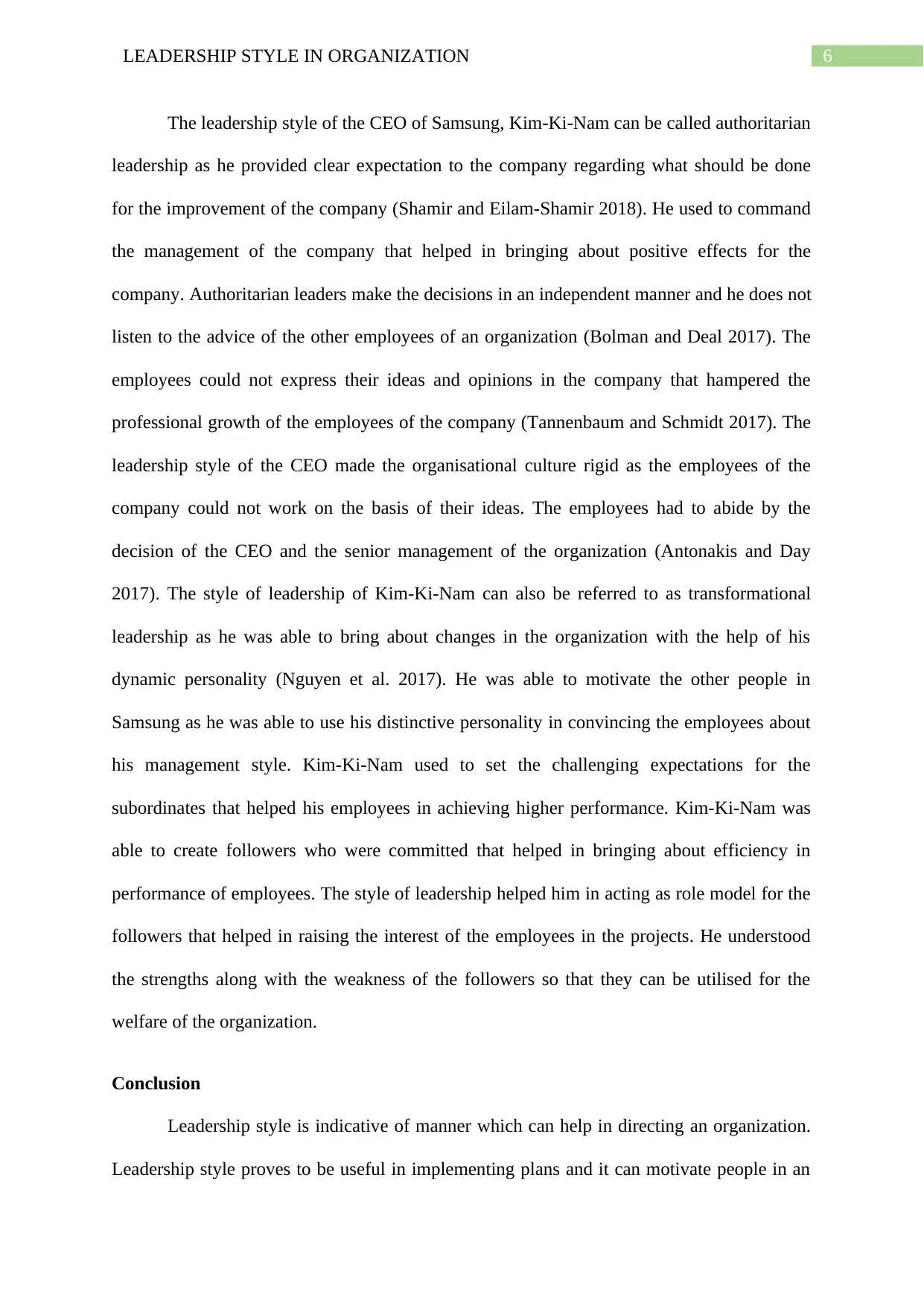
6LEADERSHIP STYLE IN ORGANIZATION
The leadership style of the CEO of Samsung, Kim-Ki-Nam can be called authoritarian
leadership as he provided clear expectation to the company regarding what should be done
for the improvement of the company (Shamir and Eilam-Shamir 2018). He used to command
the management of the company that helped in bringing about positive effects for the
company. Authoritarian leaders make the decisions in an independent manner and he does not
listen to the advice of the other employees of an organization (Bolman and Deal 2017). The
employees could not express their ideas and opinions in the company that hampered the
professional growth of the employees of the company (Tannenbaum and Schmidt 2017). The
leadership style of the CEO made the organisational culture rigid as the employees of the
company could not work on the basis of their ideas. The employees had to abide by the
decision of the CEO and the senior management of the organization (Antonakis and Day
2017). The style of leadership of Kim-Ki-Nam can also be referred to as transformational
leadership as he was able to bring about changes in the organization with the help of his
dynamic personality (Nguyen et al. 2017). He was able to motivate the other people in
Samsung as he was able to use his distinctive personality in convincing the employees about
his management style. Kim-Ki-Nam used to set the challenging expectations for the
subordinates that helped his employees in achieving higher performance. Kim-Ki-Nam was
able to create followers who were committed that helped in bringing about efficiency in
performance of employees. The style of leadership helped him in acting as role model for the
followers that helped in raising the interest of the employees in the projects. He understood
the strengths along with the weakness of the followers so that they can be utilised for the
welfare of the organization.
Conclusion
Leadership style is indicative of manner which can help in directing an organization.
Leadership style proves to be useful in implementing plans and it can motivate people in an
The leadership style of the CEO of Samsung, Kim-Ki-Nam can be called authoritarian
leadership as he provided clear expectation to the company regarding what should be done
for the improvement of the company (Shamir and Eilam-Shamir 2018). He used to command
the management of the company that helped in bringing about positive effects for the
company. Authoritarian leaders make the decisions in an independent manner and he does not
listen to the advice of the other employees of an organization (Bolman and Deal 2017). The
employees could not express their ideas and opinions in the company that hampered the
professional growth of the employees of the company (Tannenbaum and Schmidt 2017). The
leadership style of the CEO made the organisational culture rigid as the employees of the
company could not work on the basis of their ideas. The employees had to abide by the
decision of the CEO and the senior management of the organization (Antonakis and Day
2017). The style of leadership of Kim-Ki-Nam can also be referred to as transformational
leadership as he was able to bring about changes in the organization with the help of his
dynamic personality (Nguyen et al. 2017). He was able to motivate the other people in
Samsung as he was able to use his distinctive personality in convincing the employees about
his management style. Kim-Ki-Nam used to set the challenging expectations for the
subordinates that helped his employees in achieving higher performance. Kim-Ki-Nam was
able to create followers who were committed that helped in bringing about efficiency in
performance of employees. The style of leadership helped him in acting as role model for the
followers that helped in raising the interest of the employees in the projects. He understood
the strengths along with the weakness of the followers so that they can be utilised for the
welfare of the organization.
Conclusion
Leadership style is indicative of manner which can help in directing an organization.
Leadership style proves to be useful in implementing plans and it can motivate people in an
Paraphrase This Document
Need a fresh take? Get an instant paraphrase of this document with our AI Paraphraser
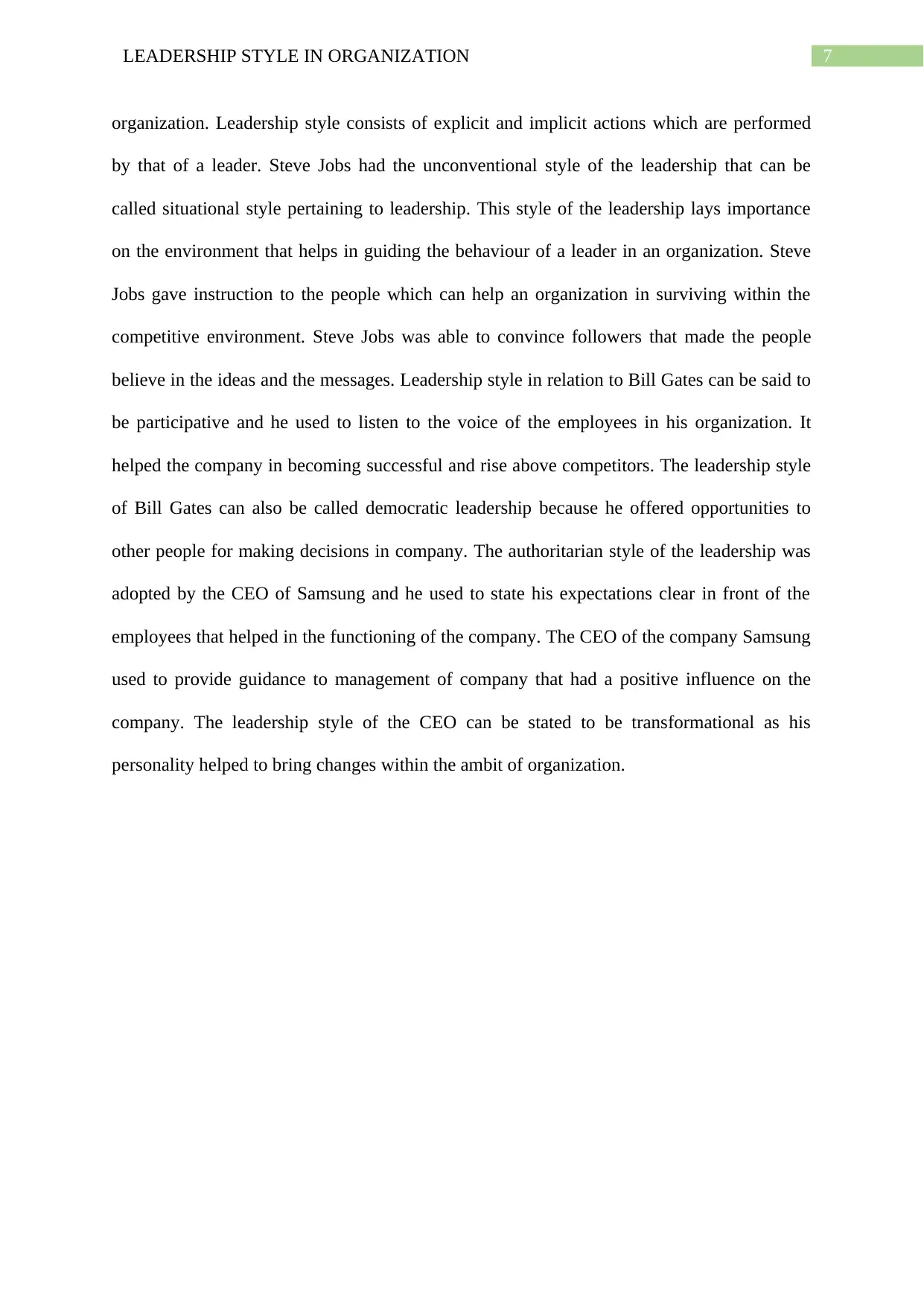
7LEADERSHIP STYLE IN ORGANIZATION
organization. Leadership style consists of explicit and implicit actions which are performed
by that of a leader. Steve Jobs had the unconventional style of the leadership that can be
called situational style pertaining to leadership. This style of the leadership lays importance
on the environment that helps in guiding the behaviour of a leader in an organization. Steve
Jobs gave instruction to the people which can help an organization in surviving within the
competitive environment. Steve Jobs was able to convince followers that made the people
believe in the ideas and the messages. Leadership style in relation to Bill Gates can be said to
be participative and he used to listen to the voice of the employees in his organization. It
helped the company in becoming successful and rise above competitors. The leadership style
of Bill Gates can also be called democratic leadership because he offered opportunities to
other people for making decisions in company. The authoritarian style of the leadership was
adopted by the CEO of Samsung and he used to state his expectations clear in front of the
employees that helped in the functioning of the company. The CEO of the company Samsung
used to provide guidance to management of company that had a positive influence on the
company. The leadership style of the CEO can be stated to be transformational as his
personality helped to bring changes within the ambit of organization.
organization. Leadership style consists of explicit and implicit actions which are performed
by that of a leader. Steve Jobs had the unconventional style of the leadership that can be
called situational style pertaining to leadership. This style of the leadership lays importance
on the environment that helps in guiding the behaviour of a leader in an organization. Steve
Jobs gave instruction to the people which can help an organization in surviving within the
competitive environment. Steve Jobs was able to convince followers that made the people
believe in the ideas and the messages. Leadership style in relation to Bill Gates can be said to
be participative and he used to listen to the voice of the employees in his organization. It
helped the company in becoming successful and rise above competitors. The leadership style
of Bill Gates can also be called democratic leadership because he offered opportunities to
other people for making decisions in company. The authoritarian style of the leadership was
adopted by the CEO of Samsung and he used to state his expectations clear in front of the
employees that helped in the functioning of the company. The CEO of the company Samsung
used to provide guidance to management of company that had a positive influence on the
company. The leadership style of the CEO can be stated to be transformational as his
personality helped to bring changes within the ambit of organization.
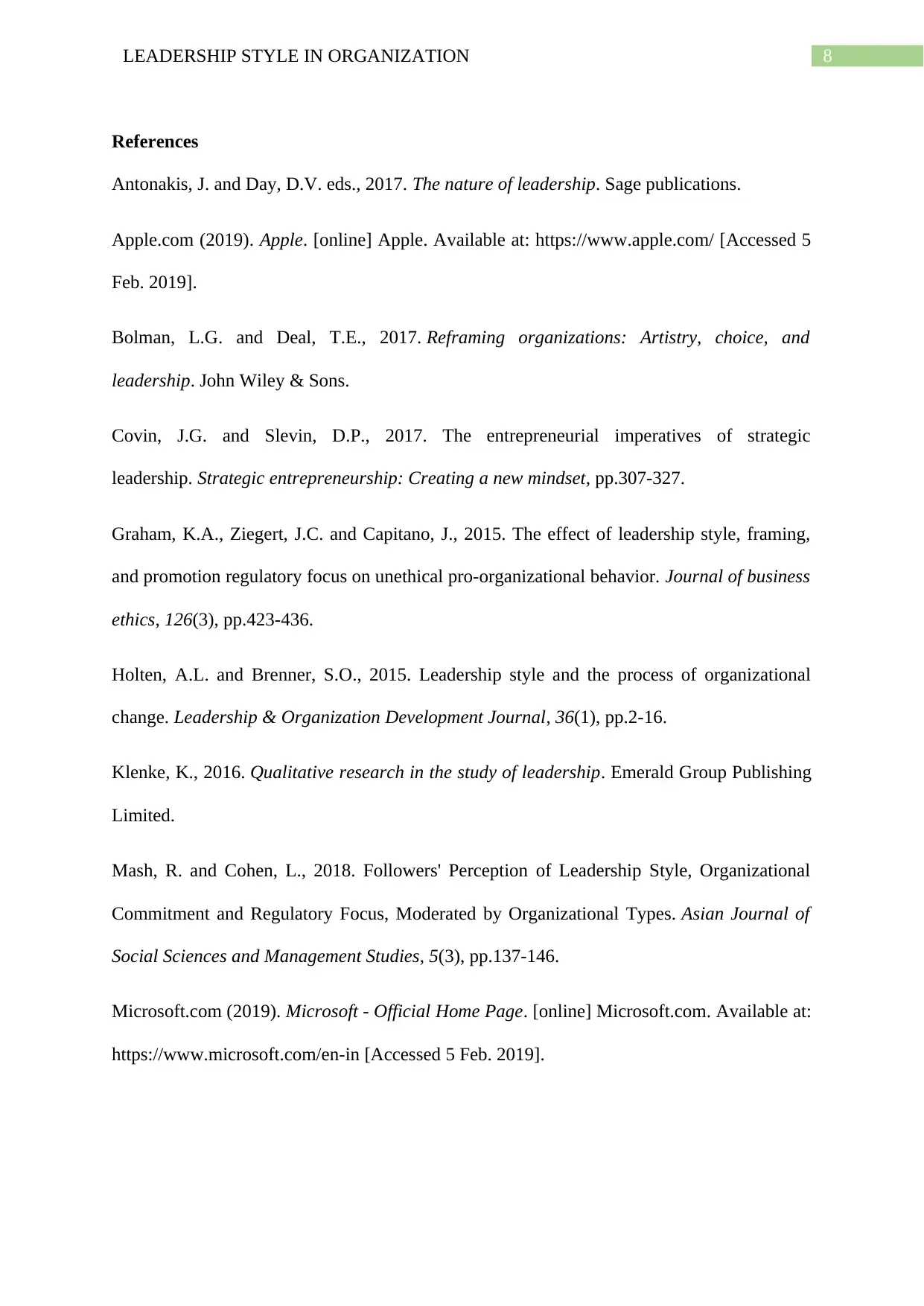
8LEADERSHIP STYLE IN ORGANIZATION
References
Antonakis, J. and Day, D.V. eds., 2017. The nature of leadership. Sage publications.
Apple.com (2019). Apple. [online] Apple. Available at: https://www.apple.com/ [Accessed 5
Feb. 2019].
Bolman, L.G. and Deal, T.E., 2017. Reframing organizations: Artistry, choice, and
leadership. John Wiley & Sons.
Covin, J.G. and Slevin, D.P., 2017. The entrepreneurial imperatives of strategic
leadership. Strategic entrepreneurship: Creating a new mindset, pp.307-327.
Graham, K.A., Ziegert, J.C. and Capitano, J., 2015. The effect of leadership style, framing,
and promotion regulatory focus on unethical pro-organizational behavior. Journal of business
ethics, 126(3), pp.423-436.
Holten, A.L. and Brenner, S.O., 2015. Leadership style and the process of organizational
change. Leadership & Organization Development Journal, 36(1), pp.2-16.
Klenke, K., 2016. Qualitative research in the study of leadership. Emerald Group Publishing
Limited.
Mash, R. and Cohen, L., 2018. Followers' Perception of Leadership Style, Organizational
Commitment and Regulatory Focus, Moderated by Organizational Types. Asian Journal of
Social Sciences and Management Studies, 5(3), pp.137-146.
Microsoft.com (2019). Microsoft - Official Home Page. [online] Microsoft.com. Available at:
https://www.microsoft.com/en-in [Accessed 5 Feb. 2019].
References
Antonakis, J. and Day, D.V. eds., 2017. The nature of leadership. Sage publications.
Apple.com (2019). Apple. [online] Apple. Available at: https://www.apple.com/ [Accessed 5
Feb. 2019].
Bolman, L.G. and Deal, T.E., 2017. Reframing organizations: Artistry, choice, and
leadership. John Wiley & Sons.
Covin, J.G. and Slevin, D.P., 2017. The entrepreneurial imperatives of strategic
leadership. Strategic entrepreneurship: Creating a new mindset, pp.307-327.
Graham, K.A., Ziegert, J.C. and Capitano, J., 2015. The effect of leadership style, framing,
and promotion regulatory focus on unethical pro-organizational behavior. Journal of business
ethics, 126(3), pp.423-436.
Holten, A.L. and Brenner, S.O., 2015. Leadership style and the process of organizational
change. Leadership & Organization Development Journal, 36(1), pp.2-16.
Klenke, K., 2016. Qualitative research in the study of leadership. Emerald Group Publishing
Limited.
Mash, R. and Cohen, L., 2018. Followers' Perception of Leadership Style, Organizational
Commitment and Regulatory Focus, Moderated by Organizational Types. Asian Journal of
Social Sciences and Management Studies, 5(3), pp.137-146.
Microsoft.com (2019). Microsoft - Official Home Page. [online] Microsoft.com. Available at:
https://www.microsoft.com/en-in [Accessed 5 Feb. 2019].
⊘ This is a preview!⊘
Do you want full access?
Subscribe today to unlock all pages.

Trusted by 1+ million students worldwide
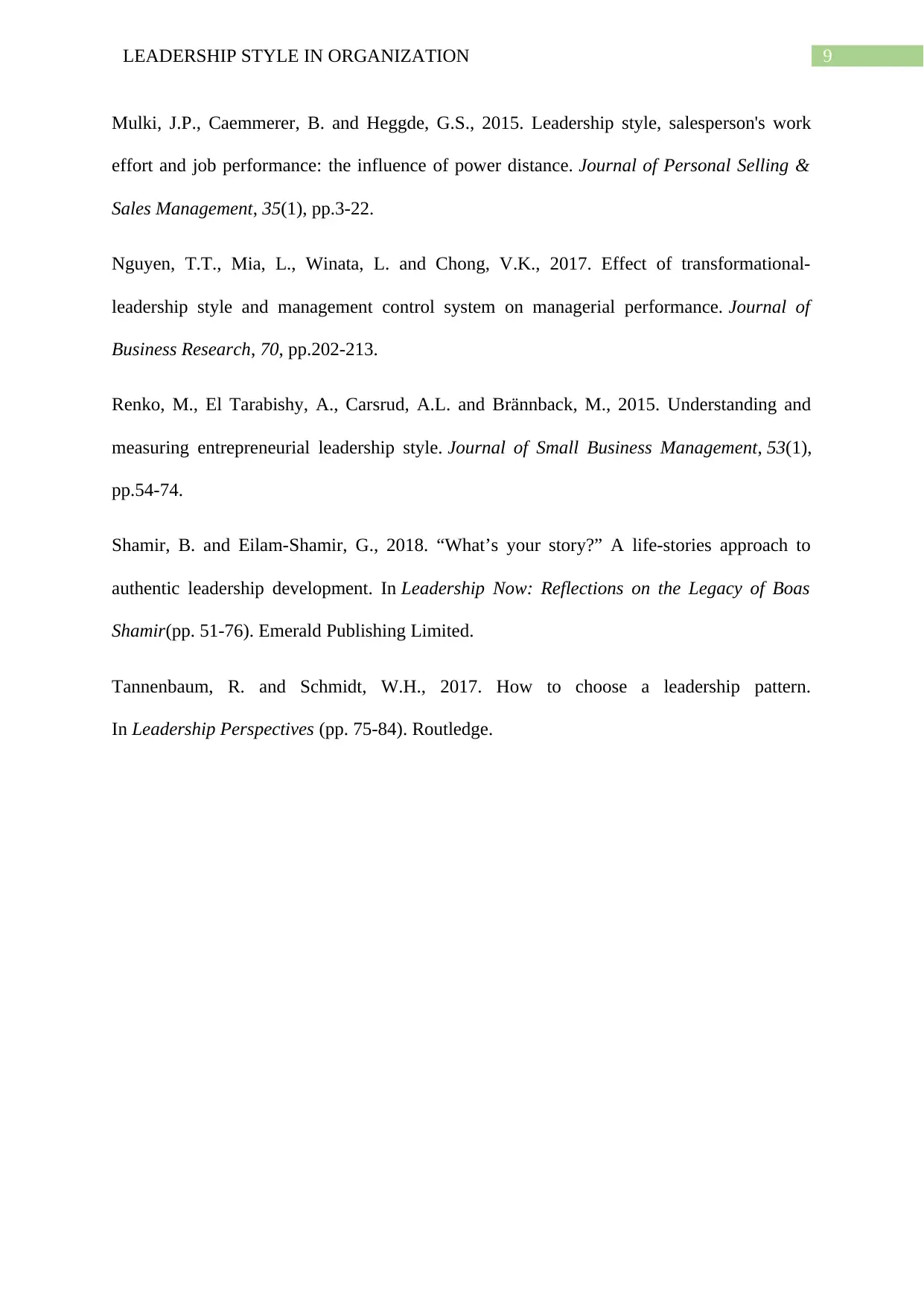
9LEADERSHIP STYLE IN ORGANIZATION
Mulki, J.P., Caemmerer, B. and Heggde, G.S., 2015. Leadership style, salesperson's work
effort and job performance: the influence of power distance. Journal of Personal Selling &
Sales Management, 35(1), pp.3-22.
Nguyen, T.T., Mia, L., Winata, L. and Chong, V.K., 2017. Effect of transformational-
leadership style and management control system on managerial performance. Journal of
Business Research, 70, pp.202-213.
Renko, M., El Tarabishy, A., Carsrud, A.L. and Brännback, M., 2015. Understanding and
measuring entrepreneurial leadership style. Journal of Small Business Management, 53(1),
pp.54-74.
Shamir, B. and Eilam-Shamir, G., 2018. “What’s your story?” A life-stories approach to
authentic leadership development. In Leadership Now: Reflections on the Legacy of Boas
Shamir(pp. 51-76). Emerald Publishing Limited.
Tannenbaum, R. and Schmidt, W.H., 2017. How to choose a leadership pattern.
In Leadership Perspectives (pp. 75-84). Routledge.
Mulki, J.P., Caemmerer, B. and Heggde, G.S., 2015. Leadership style, salesperson's work
effort and job performance: the influence of power distance. Journal of Personal Selling &
Sales Management, 35(1), pp.3-22.
Nguyen, T.T., Mia, L., Winata, L. and Chong, V.K., 2017. Effect of transformational-
leadership style and management control system on managerial performance. Journal of
Business Research, 70, pp.202-213.
Renko, M., El Tarabishy, A., Carsrud, A.L. and Brännback, M., 2015. Understanding and
measuring entrepreneurial leadership style. Journal of Small Business Management, 53(1),
pp.54-74.
Shamir, B. and Eilam-Shamir, G., 2018. “What’s your story?” A life-stories approach to
authentic leadership development. In Leadership Now: Reflections on the Legacy of Boas
Shamir(pp. 51-76). Emerald Publishing Limited.
Tannenbaum, R. and Schmidt, W.H., 2017. How to choose a leadership pattern.
In Leadership Perspectives (pp. 75-84). Routledge.
1 out of 10
Related Documents
Your All-in-One AI-Powered Toolkit for Academic Success.
+13062052269
info@desklib.com
Available 24*7 on WhatsApp / Email
![[object Object]](/_next/static/media/star-bottom.7253800d.svg)
Unlock your academic potential
Copyright © 2020–2025 A2Z Services. All Rights Reserved. Developed and managed by ZUCOL.




